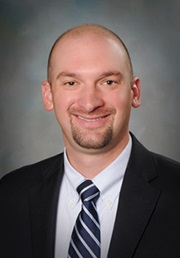Dr. Pate’s Prescription for Change
St. Luke’s Dave McFadyen on population health and reshaping care delivery


It might seem a bit strange to fill a population health leader role with a traditional hospital administrator. After all, under the fee-for-service pay structure that prevails in health care, everything is hospital-centric and hospitals are profit centers. Population health flips the model, so that hospitals are better viewed as cost centers, and we direct our efforts at coordinating care and trying to avoid preventable hospital admissions.
Within St. Luke’s, we have selected traditional hospital administrators to serve as vice presidents of population health for three areas of our health system. Aligned with our vision and committed to our strategy of population health, these hospital administrators know what our opportunities are to reduce clinical and operational variation to improve outcomes and reduce the total cost of care. They are doing a great job in thinking about our health system through a new lens.
I have always stated that we need to create the health system of the future that we want for our own care and the care of our loved ones. For St. Luke’s Vice President of Population Health Dave McFadyen, the need was sharply underscored by a family health scare recently.
- David C. Pate, M.D., J.D.

This past winter, my family experienced how thinking differently about care – not from the hospital or acute-centric model, but from the patient’s perspective – truly changes the cost and experience of care.
Late on a Friday night in November, my mom called to let me know that my dad was having a heart attack and that the ambulance was taking him to St. Luke’s Meridian Medical Center. I rushed to the hospital to find my dad surrounded by my colleagues and friends in the Emergency Room.
The coordination between team members reminded me of the videos we see of the NASCAR teams during a pit stop, with everyone knowing their role, good communication and a sense of calm amid a stressful situation.
Dad’s heart was in tough shape and he required a triple bypass surgery. But my father also suffers from many chronic and acute health conditions that do not make him a good candidate for open heart surgery. These comorbidities are the result of becoming a paraplegic 12 years ago and suffering from years of chronic health conditions. He had already made the decision to be “DNR” (“do not resuscitate”) if he were to ever face another major health event.
As I look back on all of it now, I can see how all of the events and care around this family health crisis represent what we at St. Luke’s are trying to achieve for every patient, every time, in every setting.
My role within St. Luke’s has been evolving and expanding as I move from serving as a traditional hospital administrator, primarily focused on the daily operations of a single hospital, to serving as a vice president for population health for a defined area or geography of care.
This transition, and my father’s experience, are opening my eyes to the opportunities we have to significantly reduce cost by implementing changes to reduce clinical and operational variation across the care continuum.
I am listening to and learning from physicians, board and community leaders and many clinical and operational experts in each community we serve, to better understand the health needs in these communities and to understand how St. Luke’s is performing clinically and operationally within each community.
What I have found is incredible caregivers and leaders providing excellent care with clinical outcomes that are among the best in the nation. I have also observed clinical and operational variation in how we get to those outcomes.
The goal, however, has always had to do with patients’ care, and the focus has been how the patient experiences that care. Our journey to steadily improve upon that by moving from fee for service to value goes back years, and one example is the work that our heart and vascular team has done to become one of the top 50 heart hospitals nationally. They have held that high standard and have continued to be among the ranks of those top hospitals now for more than 10 years.
Which brings us back to the care my father received. Despite my knowledge of the clinical workflows and knowledge of the great outcomes our caregivers achieve for our heart attack patients, I was amazed at the work of the care team. As I continued to observe from the perspective of a family member, I could not believe how fast everyone was working to place leads, take blood pressure, start the IV, take blood samples and so on.
At the same time, the ER physician, Dr. Nathan Andrew, was calmly educating my parents regarding the condition of my dad’s heart and facilitating the decision about the intervention in the context of the DNR already on his chart.
Dad ultimately decided to move forward with the procedure and had several stents placed successfully. Within just a few short hours, he was back to feeling much better and asking to eat.
Before he was discharged from the hospital, care coordinators, nurses and physicians moved in to implement a plan and schedule for follow-up clinic visits, education for diet and exercise, exercise classes and so on. There was no guessing what my parents should do once they returned home from the hospital. It was all clearly defined and managed, and my dad was home within 48 hours.
The coordination did not stop there. Shortly after they returned home, the rest of the care team was in contact with my dad. Each provider proactively reached out. Updates to meds and other treatments that needed to be adjusted all were coordinated, thanks to our electronic health records system and care coordination program.
The outcome my dad experienced was no accident. The care he received perfectly illustrates what happens when a health-care delivery team thinks about the patient’s care from the perspective of end-to-end care.
It also points out the opportunity we have to remove the clinical and operational variation that we experience and lower the total costs of care and increase consistent positive outcomes, which are possible when we drive out irrational variation.
For years, St. Luke’s heart and vascular team has worked with local and state leaders from EMS agencies, hospital leaders and clinician colleagues to develop the care pathways that make outcomes like my father’s possible.
I’m glad and proud to say that the care that he experienced is not unique. There are multiple stories from each service line within St. Luke’s where St. Luke’s physicians, care teams and leaders are reducing clinical and operational variation to improve outcomes. I also believe that the population health model St. Luke’s is implementing will enable us to accelerate these types of changes as we reshape care delivery at St. Luke’s, ensuring the sort of experience my family had in November.
About The Author

Dave McFadyen is the vice president for Population Health for St. Luke’s, based in Boise, Idaho.



